Modern Service Industry
Smart Logistics Park Construction Project of Baicheng City
1. Introduction to the Project
1.1 Project background
1.1.1 Product introduction
Smart logistics refers to a modern logistics model that utilizes intelligent technologies such as software and hardware, the Internet of Things, and big data to achieve refined, dynamic, and visual management of various logistics links, improve the intelligent analysis, decision-making, and automated operation execution capabilities of logistics systems, and enhance the logistics operational efficiency.
This project mainly develops multifunctional intelligent warehousing, processing, trade, shutdown, distribution, and information services, covering commodity trading areas, supporting functional areas, business administrative areas, life service areas, information management areas, etc., forming a reasonable layout of scale, informatization, networking, and chain, gradually developing into a modern automated intelligent logistics center that focuses on product trading and integrates multiple functions such as wholesale, warehousing, direct sales, distribution, transportation, testing, and information exchange.
1.1.2 Market prospect
1. Development status of the logistics industry
(1) The total scale of social logistics in China has reached a new high.
In 2023, the scale of logistics demand reached a new high, with a total social logistics volume of 352.4 trillion yuan, a year-on-year increase of 5.2% calculated at comparable prices. On a quarterly basis, the first quarter, the second quarter, the third quarter, and the fourth quarter saw growth of 3.9%, 5.4%, 4.7%, and 5.4% respectively, showing a recovery trend of low growth at the beginning, high growth in the middle, and stable growth at the end. The overall growth trend for the whole year is positive.
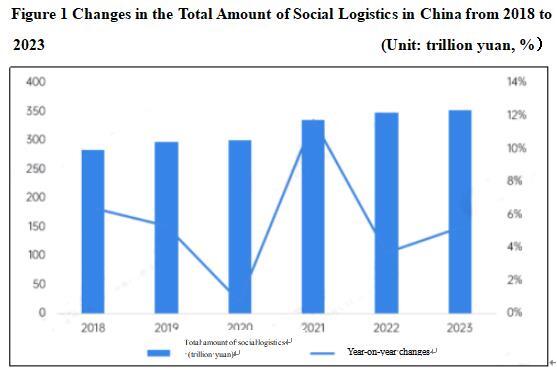
From the composition of the total logistics volume, the total logistics volume of industrial products in China exceeded 310 trillion yuan in 2023, accounting for over 88%; next was the total import logistics volume of 18 trillion yuan, accounting for 5.1%; the total amount of logistics in other fields was relatively small.
(2) The fluctuation of the ratio of total social logistics costs to GDP has decreased
From the perspective of total logistics costs, the total logistics costs in China continue to grow. The total cost of social logistics in 2023 was 17.8 trillion yuan, a year-on-year increase of 2.3%, with a slight decline in growth rate.
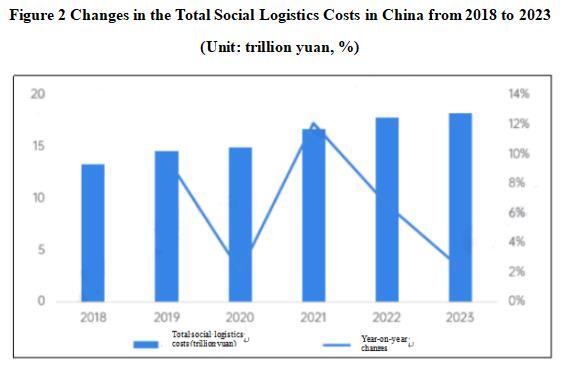
From 2015 to 2023, the overall ratio of the total social logistics costs to GDP in China showed a fluctuating downward trend. The ratio of total social logistics costs to GDP was 14.4%, a decrease of 0.3 percentage points from the previous year, reflecting the decreasing logistics costs necessary for the value of unit domestic production (GDP).
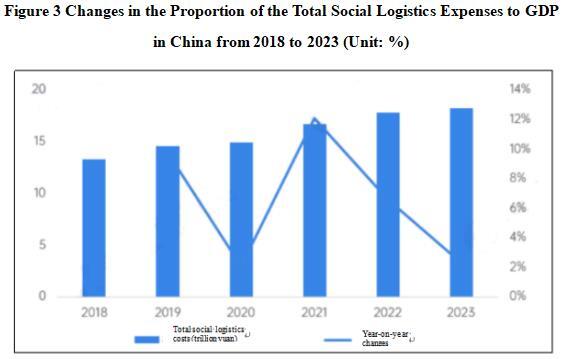
(3) The total revenue of the national logistics industry continues to grow.
According to the data from China Internet of Things, the total revenue of China’s logistics industry has been increasing year by year from 2015 to 2023. The total revenue of the logistics industry for the whole year of 2023 was 13.2 trillion yuan, a year-on-year increase of 3.9%, and the scale of logistics revenue continues to expand. The year-on-year growth rate of the basic logistics revenue such as transportation, warehousing, loading and unloading is around 3%, supporting the stable growth of the logistics market.
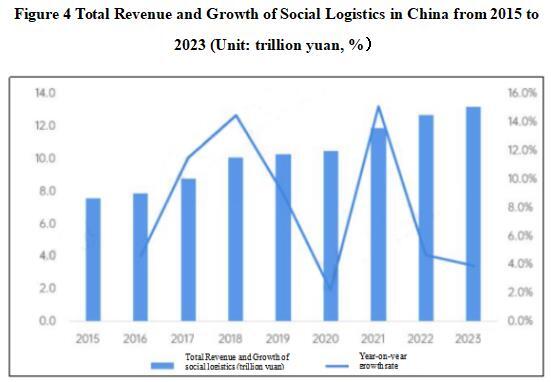
2. Competitive landscape in the logistics industry
(1) Regional competition pattern
The logistics park plays a significant role in economic development, promoting the integration of multiple transportation modes, and improving the urban environment. In recent years, the government and enterprises have unanimously regarded it as a key project to promote regional and urban logistics development, providing strong support.
As of the end of 2023, the National Development and Reform Commission has led the layout and construction of 80 national logistics hubs, covering 29 provinces (regions, cities) and the Xinjiang Production and Construction Corps, laying a solid foundation for accelerating the construction of a modern logistics operation system of “channel+hub+network” and supporting the construction of a new development pattern. From the perspective of regional distribution, Guangdong has the highest number of national logistics hubs.
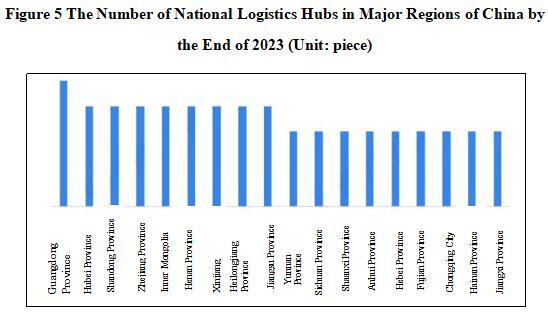
(2) Competitive landscape of enterprises
According to the list of the top 10 logistics companies in China in 2023 released by China IoT, COSCO Shipping Group, Xiamen Xiangyu, and SF Holding Co., Ltd. are among the top three. There are five companies with logistics business revenues of over 100 billion yuan, making them the backbone of the industry, and the industry clustering effect continues to emerge.
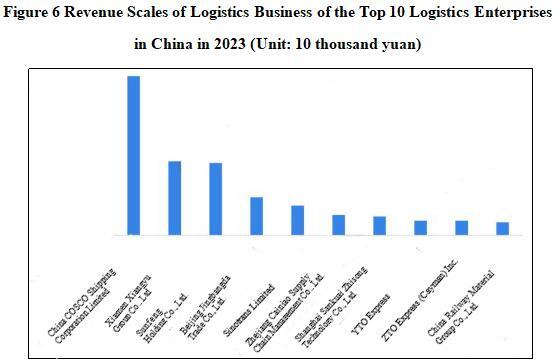
3. Development prospects
(1) Continuously promote green, low-carbon, and high-quality development.
According to the 14th Five-Year Plan for the Construction of Modern Circulation System released by the National Development and Reform Commission, it is expected that by 2035, China’s modern circulation system will have been fully established, forming a global, safe, reliable, efficient and smooth circulation network. The efficiency and quality of circulation operation will have reached the world’s advanced level, and new advantages in participating in international cooperation and competition will have been significantly enhanced. This will provide efficient support for the modern economic system and provide solid guarantees for meeting the needs of the people for a better life.
(2) Forecast of China’s total social logistics revenue prospects
In the future, China will focus on filling the gaps in the modern circulation system, focusing on the high-quality development of the modern circulation system, accelerating the formation of a unified modern circulation market, and developing the two major systems of modern commercial circulation and modern logistics to further improve China’s logistics system. Based on the trend of changes in the total amount and revenue of social logistics in China in recent years, it is predicted that the total revenue of social logistics in China will have reached 17.9 trillion yuan by the end of 2029.
1.1.3 Advantageous conditions of project construction
(1) Policy advantages
The Outline for Building a Quality Strong Country proposes to actively develop multimodal transport, smart logistics, and supply chain logistics, improve the quality of cold chain logistics services, optimize international logistics channels, and enhance the convenience of port clearance.
The 14th Five-Year Plan for the Development of Modern Logistics proposes to encourage cities with conditions to build smart logistics “brains”, comprehensively link and promote the sharing of urban logistics resources, optimize urban logistics operations, and build smart logistics networks.
The Special Action Plan for High Quality Development of Commercial Logistics (2021-2025) proposes to strengthen the planning of cold chain logistics, layout and construct a number of national backbone cold chain logistics bases, support the construction and renovation of large-scale agricultural product wholesale markets, import and export ports, and promote the application of new cold chain facilities and equipment such as mobile cold storage, constant temperature refrigerated trucks, and refrigerated containers. Improve the equipment of end of pipe cold chain facilities and enhance the network coverage level of urban and rural cold chain facilities. Encourage eligible enterprises to develop intelligent monitoring and traceability platforms for cold chain logistics, and establish a full process cold chain distribution system.
The Notice on Further Strengthening the Construction of Cold Chain Facilities for Agricultural Product Storage and Preservation proposes to further promote the construction of cold chain facilities for agricultural product storage and preservation, standardize process management, increase policy support, focus on supervision and management, optimize guidance services, and maximize policy benefits.
The Notice on Supporting the Construction of Pilot Cities for Modern Commercial and Trade Circulation System proposes to support the construction and transformation of regional cold chain logistics bases, enhance comprehensive capabilities such as refrigeration, processing, and distribution, connect production, sales, and distribution centers, and connect with national backbone cold chain logistics bases, production cold chain freshness preservation facilities, etc., to facilitate the transportation of industrial products to rural areas and agricultural products to urban areas.
The Guiding Opinions on Cultivating Traditional Advantageous Food Production Areas and Local Characteristic Food Industries propose to strengthen the construction of cold chain logistics facilities for agricultural products such as pre-cooling, storage, and preservation, and fill the gap of the “first kilometer” of food raw materials.
The Notice of the General Office of the People’s Government of Jilin Province on Several Policy Measures to Support the High-quality Development of Cold Chain Logistics proposes to support eligible regions to apply for the establishment of national and provincial backbone cold chain logistics bases and cold chain logistics distribution centers, and accelerate the filling of the basic, public, and public welfare logistics infrastructure gaps within the cold chain logistics bases. Support the operation entities of cold chain logistics bases or leading cold chain logistics enterprises to integrate and optimize cold chain stock resources, and lay out the construction of cold chain logistics networks for the “first kilometer” of production areas and the “last kilometer” of sales areas. Actively develop multimodal cold chain logistics, postal express delivery, and air freight, and build a comprehensive three-dimensional cold chain logistics network of public, railway, water, and air transportation.
(2) Resource advantages
Land resources. The cultivated land area in Taobei District is 2.6 million mu, including 800000 mu of paddy fields and 1.8 million mu of dry land, mostly consisting of fertile soils such as black calcareous soil and meadow soil. The forest area is 343000 mu, with a forest coverage rate of 9.26%. The total area of grassland is 260000 mu, and it is rich in high-quality forage such as sheepgrass. Other land resources are abundant.
Water resources. The average annual precipitation in Taobei District is about 349.9 millimeters. The total amount of groundwater resources is 478 million cubic meters, and the total amount of groundwater extraction is 508 million cubic meters. The Tao’er River, the largest tributary on the right bank of the Nenjiang River, flows through 6 townships and 1 farm in the area, with a total length of about 159.6 kilometers and a drainage area of about 2053 square kilometers.
Wind energy resources. The total exploitable capacity of wind energy is 22.8 million kilowatts. The installed capacity of wind power grid connected reached 3.84 million kilowatts, accounting for 67% of the province’s total (5.77 million kilowatts). According to the development plan led by the Provincial Electric Power Survey and Design Institute, a wind power area of 5060 square kilometers can be developed, and in the future, the planned centralized installed capacity will exceed 16 million kilowatts, and the distributed development installed capacity will exceed 10 million kilowatts. Among them, the wind power grid connected installed capacity in Taobei District is 350000 kilowatts, with a potential wind power development area of 215.2 square kilometers and a planned installed capacity of 700000 kilowatts.
Light energy resources. The area has abundant sunshine and high solar radiation energy, with an average annual total solar radiation of about 5300 megajoules per square meter and an annual sunshine duration of over 2900 hours, which can be utilized for 1500-1700 hours. It belongs to the “resource-rich” area and is suitable for the construction of large-scale photovoltaic power stations. By now, 5 photovoltaic power stations have been built, achieving grid connected power generation of 86.5 megawatts, including 10 megawatts from Huaneng, 15 megawatts from Zhongjin Jiangding, 15 megawatts from Huaru Photovoltaic Grass Project, 20 megawatts from the Top 100 Photovoltaic Poverty Alleviation Power Stations, and 26.5 megawatts from village-level photovoltaic poverty alleviation power stations.
(3) Industrial advantages
Baicheng has not only corn, rice, sorghum, mung bean and other food crops, but also sunflower, castor, peanut, pepper, watermelon, cantaloupe and other characteristic cash crops, as well as pig, cattle, sheep, chicken, duck, goose, wild goose and other livestock and poultry products, as well as a large number of freshwater fish, which are rich in variety and good in structure.
Baicheng is located at the junction of Jilin Province, Heilongjiang Province, and Inner Mongolia. It is a historically formed trading and distribution center for miscellaneous grain and bean products, with the largest Taonan miscellaneous grain and bean market in China, accounting for 27% of the country’s annual trading volume. It has been approved as a national demonstration base for the transformation and upgrading of miscellaneous grain foreign trade and a national demonstration zone for the quality and safety of exported miscellaneous grain and bean products. At present, there are 9 specialized wholesale markets for miscellaneous grains and beans in the city, among which Taonan Coarse Grains and Beans Trading Park has developed into the second largest specialized wholesale market for miscellaneous grains and beans in the country. There are more than 2000 operating households, including 50 industrial enterprises (industry households) , 18 agricultural and sideline product trading companies, 80 agricultural and sideline product storage and operation households, 13 self operated miscellaneous grain and bean trading households with export rights, 106 service industry households, and more than 1600 long and short distance transportation households. It mainly engages in processing and trading activities of mung beans, cowpeas, kidney beans, buckwheat, sorghum, chili peppers, mushrooms, sesame seeds, Yinghua, and corn. The average annual trading volume is 1 million tons, with a trading volume of nearly 6 billion yuan, radiating to most regions of Jilin Province, eastern Inner Mongolia, Heilongjiang, and Liaoning. Currently, it has developed into the largest trading center for miscellaneous grains and beans in the country. There are over 500 distribution enterprises for miscellaneous grains and beans in the city, including 41 with fixed assets of over 10 million yuan and 52 with import and export rights. The total annual distribution volume is 180000 tons (gathering 40000 tons from surrounding areas), and the products are mainly exported to countries and regions such as Japan, South Korea, the Philippines, the Netherlands, the United Kingdom, France, the United States, and Canada.
(4) Talent advantages
Baicheng City has several colleges and universities, including Baicheng Normal University, Baicheng Medical College, and Baicheng Vocational and Technical College. It is actively introducing Baicheng Industrial Vocational and Technical College. After the college is completed, it plans to recruit more than 2000 undergraduate students annually from the whole province and the country, and reach a scale of 10000 students in 4-5 years. At that time, a “university city” with a total of nearly 50000 teachers and students will be formed together with Baicheng Normal University and Baicheng Medical College, which can provide professional technical talents for the project.
(5) Location advantages
Baicheng City, located at the junction of Horqin Grassland and Songnen Plain, is the only way to enter the customs in the west of Heilongjiang Province and the east of Inner Mongolia Autonomous Region. It is one of the major hub cities of the fourth Eurasian Continental Bridge planned by the United Nations Development Programme, and also an important carrier area of the national Changchun-Jilin-Tumen strategy of “going west”, a radiation driven area of the Harbin-Changchun Urban Cluster, and an important node city of the China-Mongolia-Russia economic corridor in the “Belt and Road” strategy.
There are four main railway lines within the territory, namely, Changchun-Baicheng, Siping-Qiqihar, Baicheng-Arshan, and Tongliao-Rangluhe. The Changchun-Baicheng Express Railway can reach Changchun, the provincial capital in as fast as 2 hours and 38 minutes; thirteen provincial-level and above highways, including No. G302 National Highway Hunchun-Arshan Line, No. G231 National Highway Nenjing-Shuangliao Line, and No. S211 Provincial Highway Zhatu Line, connect the entire region. The Hunchun-Ulanhot, Shuangliao-Nenjiang, and Tieli-Horqin Right Middle Banner expressways intersect and connect; Da’an Port, along the Nenjiang River, provides direct access to Boli Port in Russia, making it the only waterway for direct trade between the province and the Far East of Russia; Baicheng Chang’an Airport has opened routes to Beijing, Shanghai, Tianjin, Shijiazhuang, Qingdao, Dalian and other cities, building an efficient, convenient and optimized transportation network.
1.2 Contents and scale of project construction
The project has a planned land area of 200000 square meters, a total construction area of 150000 square meters, a product trading area of 90000 square meters, a street facing commercial market of 4000 square meters, and a direct sales area for farmers of 6000 square meters; the building area of the refrigerated warehouse is 10000 square meters, the building area of the ordinary storage, processing and distribution area is 20000 square meters, the building area of the business administrative area is 10000 square meters, and the building area of the living service area is 10000 square meters, including municipal supporting facilities such as drainage networks, power supply, communication, roads, and greening.
1.3 Total investment of the project and capital raising
1.3.1 Total investment of the project
The total investment of the project is 450 million yuan, including the construction investment of 360 million yuan and current funds of 90 million yuan.
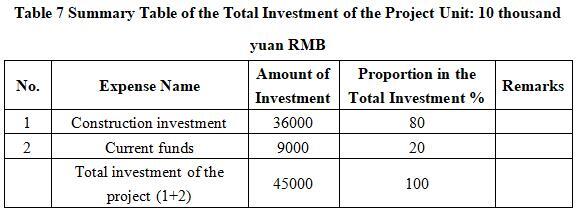
1.3.2 Capital raising
Self-raising by the enterprise
1.4 Financial analysis and social evaluation
1.4.1 Main financial indexes
After the project reaches the production capacity, its annual sales revenue will be 530 million yuan, its profit will be 80 million yuan, its investment payback period will be 8 years (after the tax, including the construction period of 2 years) and its return on investment will be 17.78%.
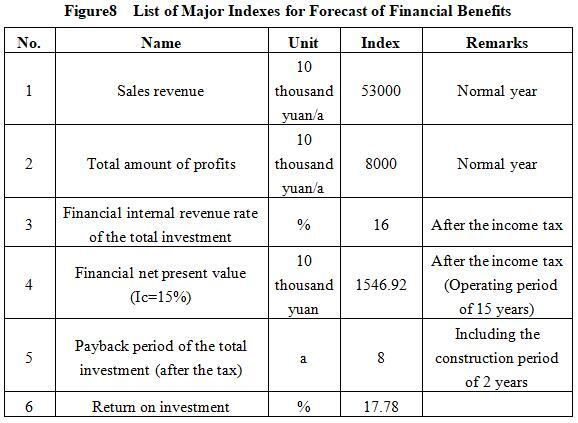
Note: “10 thousand yuan” in the table is in RMB.
1.4.2 Social evaluation
The project aims to build a modern warehousing and logistics service industry, and through information technology, will achieve effective allocation of logistics resources, greatly facilitating logistics transportation between Baicheng City and surrounding cities. From a long-term perspective, it will save a lot of transportation costs.
1.5 Cooperative way
Joint venture, cooperation or sole proprietorship, and other methods can be discussed face-to-face.
1.6 What to be invested by the foreign party
Funds, and other methods can be discussed face-to-face.
1.7 Construction site of the project
Baicheng Economic Development Zone
1.8 Progress of the project
It is attracting foreign investment.
2. Introduction to the Partner
2.1 Basic information
Name: Investment Promotion Bureau of Baicheng Economic Development Zone
Address: 88 Xingfu South Street, Baicheng City
2.2 Overview
Baicheng Economic Development Zone was established in February, 1998 with the approval of Jilin Provincial Government. It is the first provincial-level development zone in the urban area of Baicheng, located in the southwest of the city and embedded in the exit area of the Taonan-Baicheng Economic Corridor. The development zone covers an area of 171 square kilometers, with jurisdiction over three street offices, that is, Xingfu, Baoping, and Xijiao, 14 administrative villages, 9 communities, and a population of 130000. After more than 20 years of construction and development, it has continuously consolidated the pillar industries, optimized the investment environment, and been committed to expanding commercial logistics, optimizing manufacturing, and strengthening cultural industries. Its comprehensive economic strength has significantly increased, social undertakings have made comprehensive progress, and the development environment has been increasingly optimized. Its carrying capacity has been further enhanced, and it has become the strongest economic strength, best living environment, and most active commercial logistics ecological new city in the western part of Baicheng city, continuously releasing the power of vigorous development.
2.3 Contact method
Postal code: 137000
Contact person: Sun Zhonggang
Tel: +86-436-3561069 +86-15904363335
E-mail: 1191340504@qq.com
Contact method of the city (prefecture) where the project is located:
Contact person: Xu Zengchun
Tel: +86-436-3203010 +86-13894682986
Fax: +86-436-3224565
E-mail: bcjhj07@126.com


